University Literature Review: Steps, Styles, and Sources
VerifiedAdded on 2020/03/04
|12
|2983
|1232
Report
AI Summary
This report provides a comprehensive analysis of literature reviews, examining their structure, various styles, and the process of source evaluation. The report begins by outlining the fundamental steps involved in conducting a literature review, emphasizing the importance of a systematic approach. It then delves into different writing styles, including narrative and comparative analysis, and discusses the strengths and weaknesses of each. The report explores the ways of finding and evaluating sources, highlighting the significance of both primary and secondary resources. The role of theories and concepts in literature reviews is also discussed, with an assessment of their impact on the overall research. The study critically evaluates the opinions of five scholarly papers, providing insights into the key elements that contribute to a well-structured and effective literature review, designed to assist students in their academic endeavors. The conclusion underscores the importance of critical evaluation and argumentative conclusions in literature reviews.
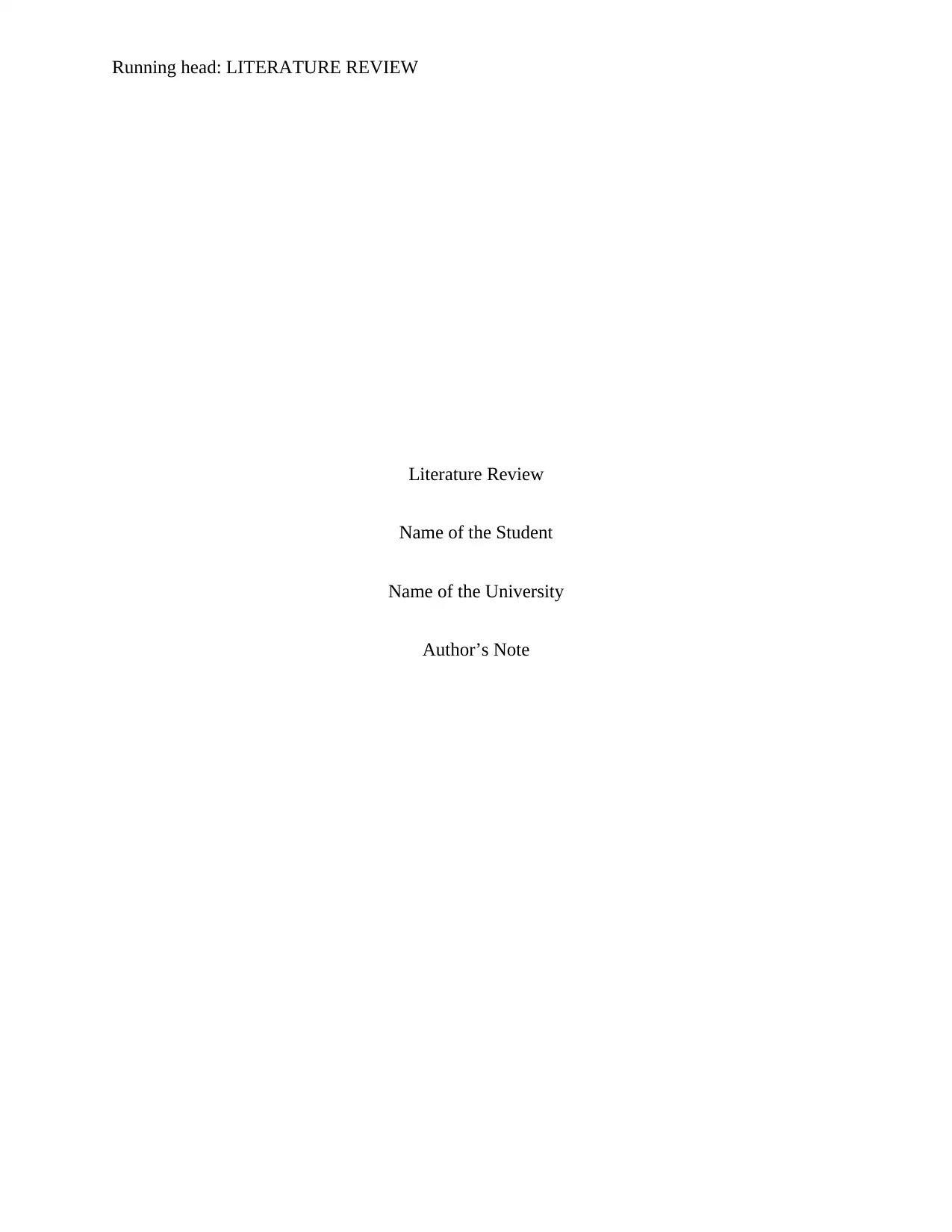
Running head: LITERATURE REVIEW
Literature Review
Name of the Student
Name of the University
Author’s Note
Literature Review
Name of the Student
Name of the University
Author’s Note
Paraphrase This Document
Need a fresh take? Get an instant paraphrase of this document with our AI Paraphraser
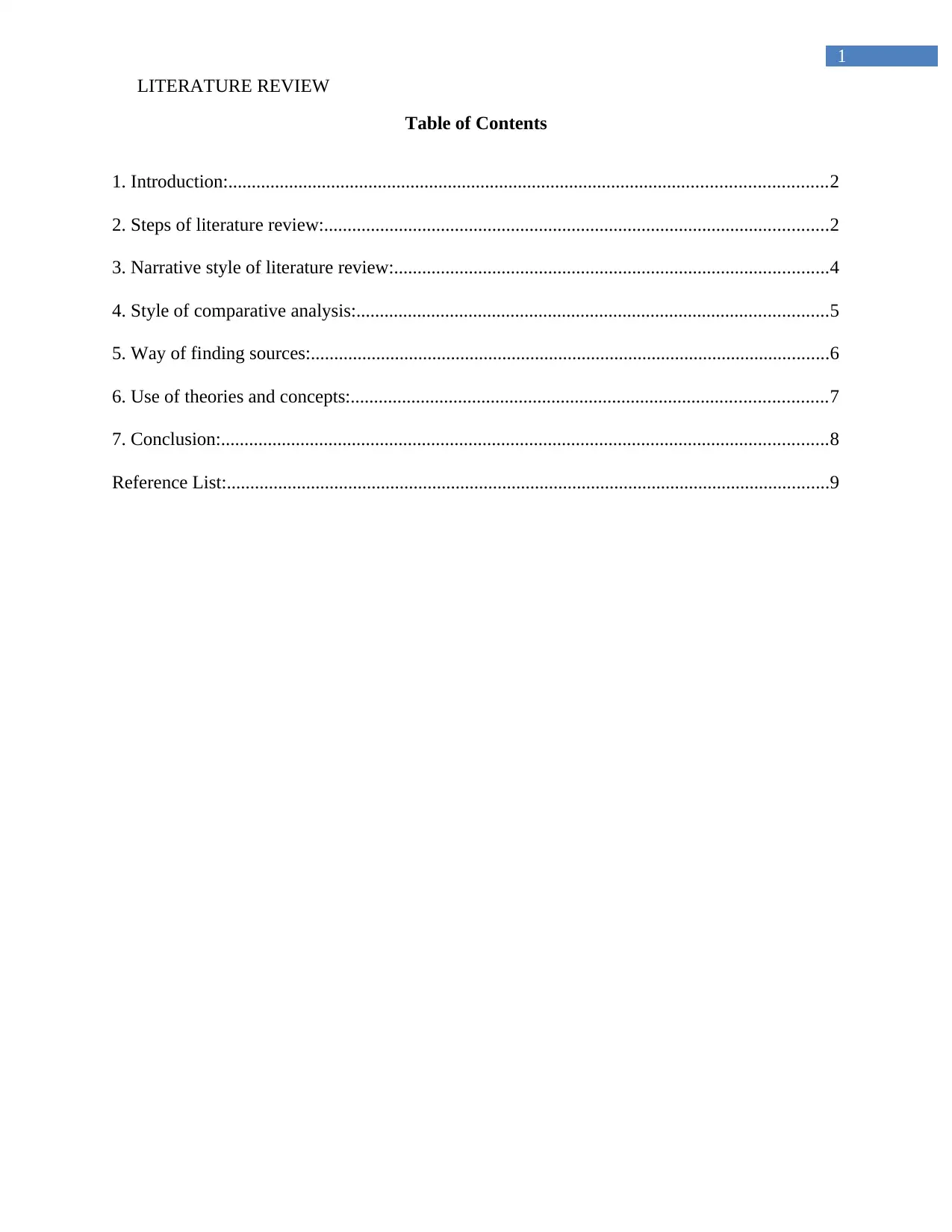
1
LITERATURE REVIEW
Table of Contents
1. Introduction:................................................................................................................................2
2. Steps of literature review:............................................................................................................2
3. Narrative style of literature review:.............................................................................................4
4. Style of comparative analysis:.....................................................................................................5
5. Way of finding sources:...............................................................................................................6
6. Use of theories and concepts:......................................................................................................7
7. Conclusion:..................................................................................................................................8
Reference List:.................................................................................................................................9
LITERATURE REVIEW
Table of Contents
1. Introduction:................................................................................................................................2
2. Steps of literature review:............................................................................................................2
3. Narrative style of literature review:.............................................................................................4
4. Style of comparative analysis:.....................................................................................................5
5. Way of finding sources:...............................................................................................................6
6. Use of theories and concepts:......................................................................................................7
7. Conclusion:..................................................................................................................................8
Reference List:.................................................................................................................................9
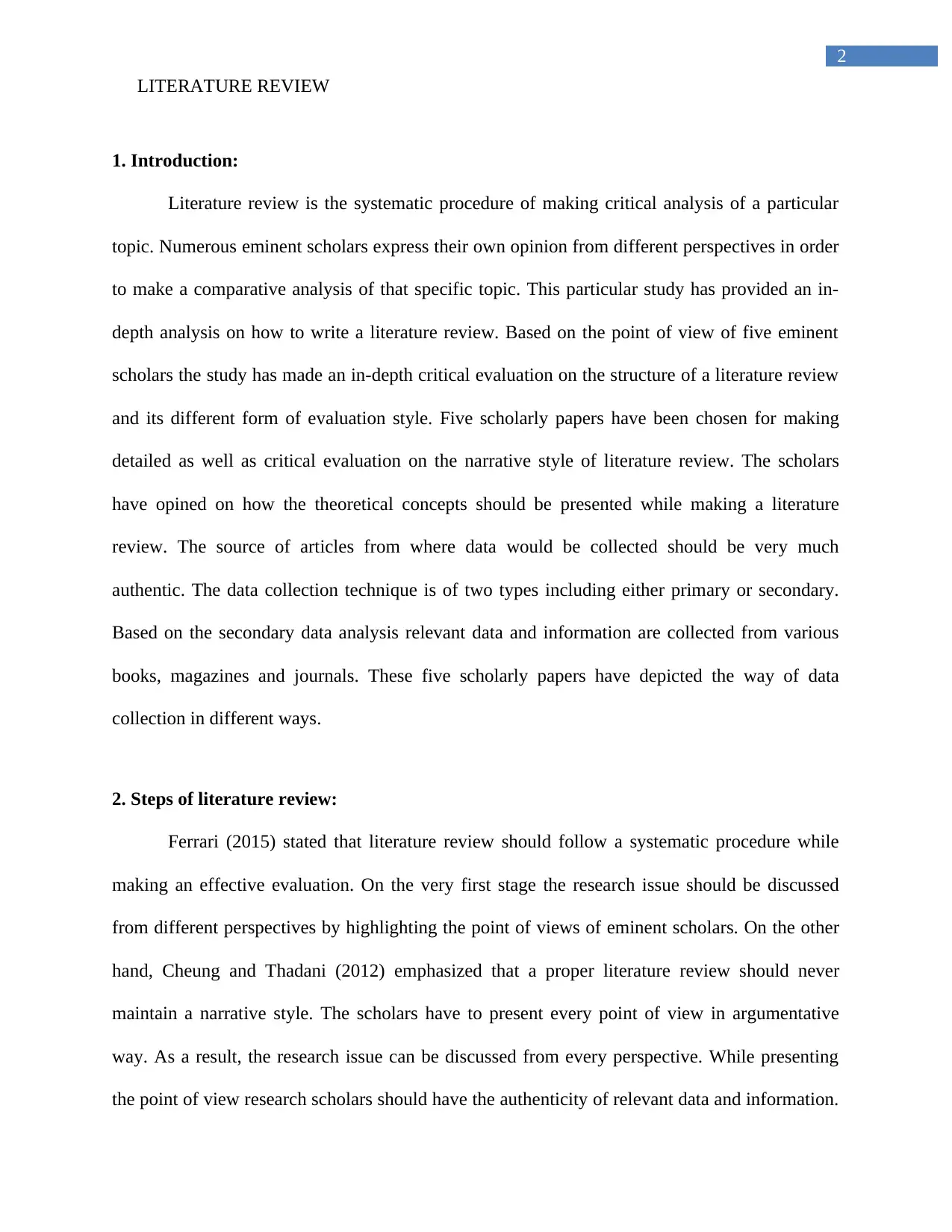
2
LITERATURE REVIEW
1. Introduction:
Literature review is the systematic procedure of making critical analysis of a particular
topic. Numerous eminent scholars express their own opinion from different perspectives in order
to make a comparative analysis of that specific topic. This particular study has provided an in-
depth analysis on how to write a literature review. Based on the point of view of five eminent
scholars the study has made an in-depth critical evaluation on the structure of a literature review
and its different form of evaluation style. Five scholarly papers have been chosen for making
detailed as well as critical evaluation on the narrative style of literature review. The scholars
have opined on how the theoretical concepts should be presented while making a literature
review. The source of articles from where data would be collected should be very much
authentic. The data collection technique is of two types including either primary or secondary.
Based on the secondary data analysis relevant data and information are collected from various
books, magazines and journals. These five scholarly papers have depicted the way of data
collection in different ways.
2. Steps of literature review:
Ferrari (2015) stated that literature review should follow a systematic procedure while
making an effective evaluation. On the very first stage the research issue should be discussed
from different perspectives by highlighting the point of views of eminent scholars. On the other
hand, Cheung and Thadani (2012) emphasized that a proper literature review should never
maintain a narrative style. The scholars have to present every point of view in argumentative
way. As a result, the research issue can be discussed from every perspective. While presenting
the point of view research scholars should have the authenticity of relevant data and information.
LITERATURE REVIEW
1. Introduction:
Literature review is the systematic procedure of making critical analysis of a particular
topic. Numerous eminent scholars express their own opinion from different perspectives in order
to make a comparative analysis of that specific topic. This particular study has provided an in-
depth analysis on how to write a literature review. Based on the point of view of five eminent
scholars the study has made an in-depth critical evaluation on the structure of a literature review
and its different form of evaluation style. Five scholarly papers have been chosen for making
detailed as well as critical evaluation on the narrative style of literature review. The scholars
have opined on how the theoretical concepts should be presented while making a literature
review. The source of articles from where data would be collected should be very much
authentic. The data collection technique is of two types including either primary or secondary.
Based on the secondary data analysis relevant data and information are collected from various
books, magazines and journals. These five scholarly papers have depicted the way of data
collection in different ways.
2. Steps of literature review:
Ferrari (2015) stated that literature review should follow a systematic procedure while
making an effective evaluation. On the very first stage the research issue should be discussed
from different perspectives by highlighting the point of views of eminent scholars. On the other
hand, Cheung and Thadani (2012) emphasized that a proper literature review should never
maintain a narrative style. The scholars have to present every point of view in argumentative
way. As a result, the research issue can be discussed from every perspective. While presenting
the point of view research scholars should have the authenticity of relevant data and information.
⊘ This is a preview!⊘
Do you want full access?
Subscribe today to unlock all pages.

Trusted by 1+ million students worldwide
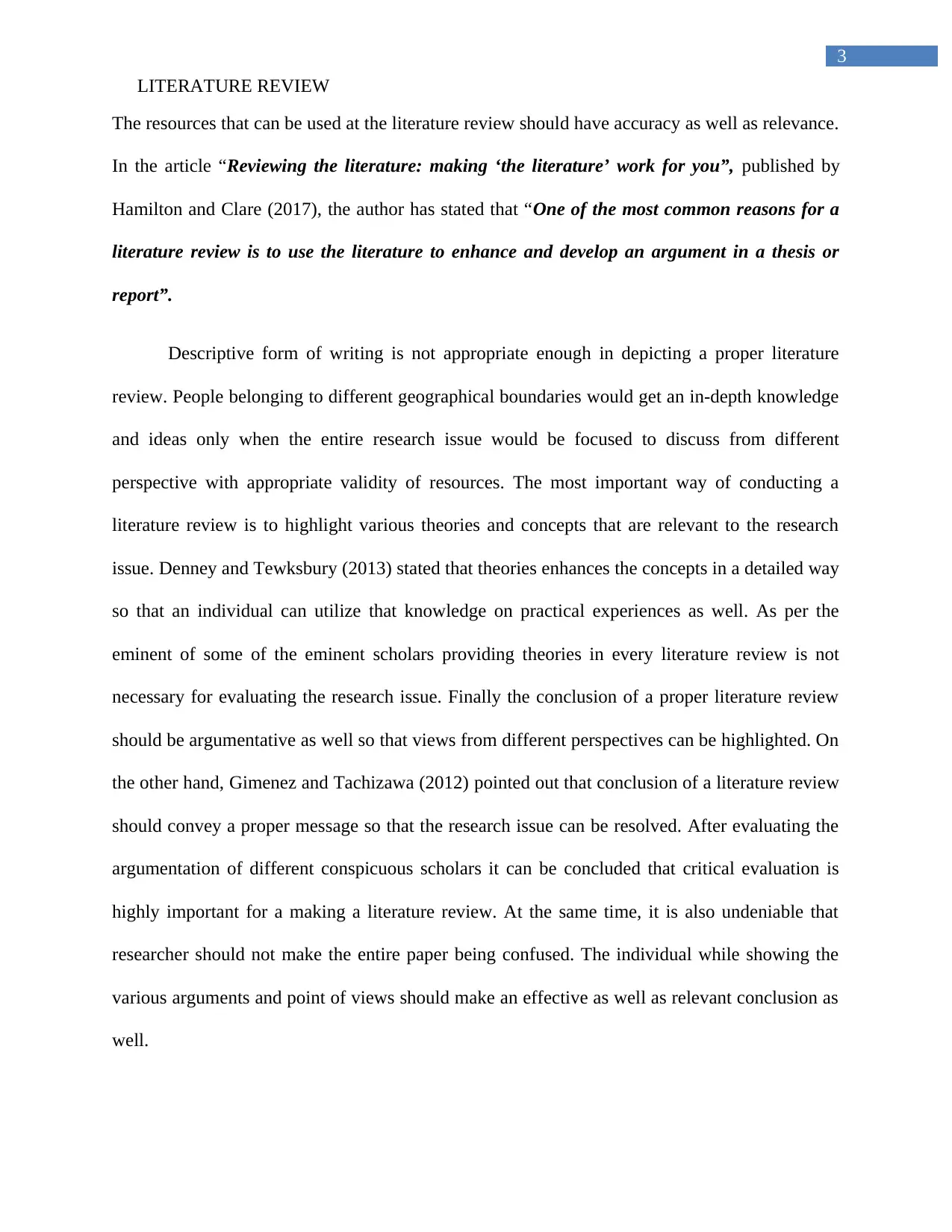
3
LITERATURE REVIEW
The resources that can be used at the literature review should have accuracy as well as relevance.
In the article “Reviewing the literature: making ‘the literature’ work for you”, published by
Hamilton and Clare (2017), the author has stated that “One of the most common reasons for a
literature review is to use the literature to enhance and develop an argument in a thesis or
report”.
Descriptive form of writing is not appropriate enough in depicting a proper literature
review. People belonging to different geographical boundaries would get an in-depth knowledge
and ideas only when the entire research issue would be focused to discuss from different
perspective with appropriate validity of resources. The most important way of conducting a
literature review is to highlight various theories and concepts that are relevant to the research
issue. Denney and Tewksbury (2013) stated that theories enhances the concepts in a detailed way
so that an individual can utilize that knowledge on practical experiences as well. As per the
eminent of some of the eminent scholars providing theories in every literature review is not
necessary for evaluating the research issue. Finally the conclusion of a proper literature review
should be argumentative as well so that views from different perspectives can be highlighted. On
the other hand, Gimenez and Tachizawa (2012) pointed out that conclusion of a literature review
should convey a proper message so that the research issue can be resolved. After evaluating the
argumentation of different conspicuous scholars it can be concluded that critical evaluation is
highly important for a making a literature review. At the same time, it is also undeniable that
researcher should not make the entire paper being confused. The individual while showing the
various arguments and point of views should make an effective as well as relevant conclusion as
well.
LITERATURE REVIEW
The resources that can be used at the literature review should have accuracy as well as relevance.
In the article “Reviewing the literature: making ‘the literature’ work for you”, published by
Hamilton and Clare (2017), the author has stated that “One of the most common reasons for a
literature review is to use the literature to enhance and develop an argument in a thesis or
report”.
Descriptive form of writing is not appropriate enough in depicting a proper literature
review. People belonging to different geographical boundaries would get an in-depth knowledge
and ideas only when the entire research issue would be focused to discuss from different
perspective with appropriate validity of resources. The most important way of conducting a
literature review is to highlight various theories and concepts that are relevant to the research
issue. Denney and Tewksbury (2013) stated that theories enhances the concepts in a detailed way
so that an individual can utilize that knowledge on practical experiences as well. As per the
eminent of some of the eminent scholars providing theories in every literature review is not
necessary for evaluating the research issue. Finally the conclusion of a proper literature review
should be argumentative as well so that views from different perspectives can be highlighted. On
the other hand, Gimenez and Tachizawa (2012) pointed out that conclusion of a literature review
should convey a proper message so that the research issue can be resolved. After evaluating the
argumentation of different conspicuous scholars it can be concluded that critical evaluation is
highly important for a making a literature review. At the same time, it is also undeniable that
researcher should not make the entire paper being confused. The individual while showing the
various arguments and point of views should make an effective as well as relevant conclusion as
well.
Paraphrase This Document
Need a fresh take? Get an instant paraphrase of this document with our AI Paraphraser
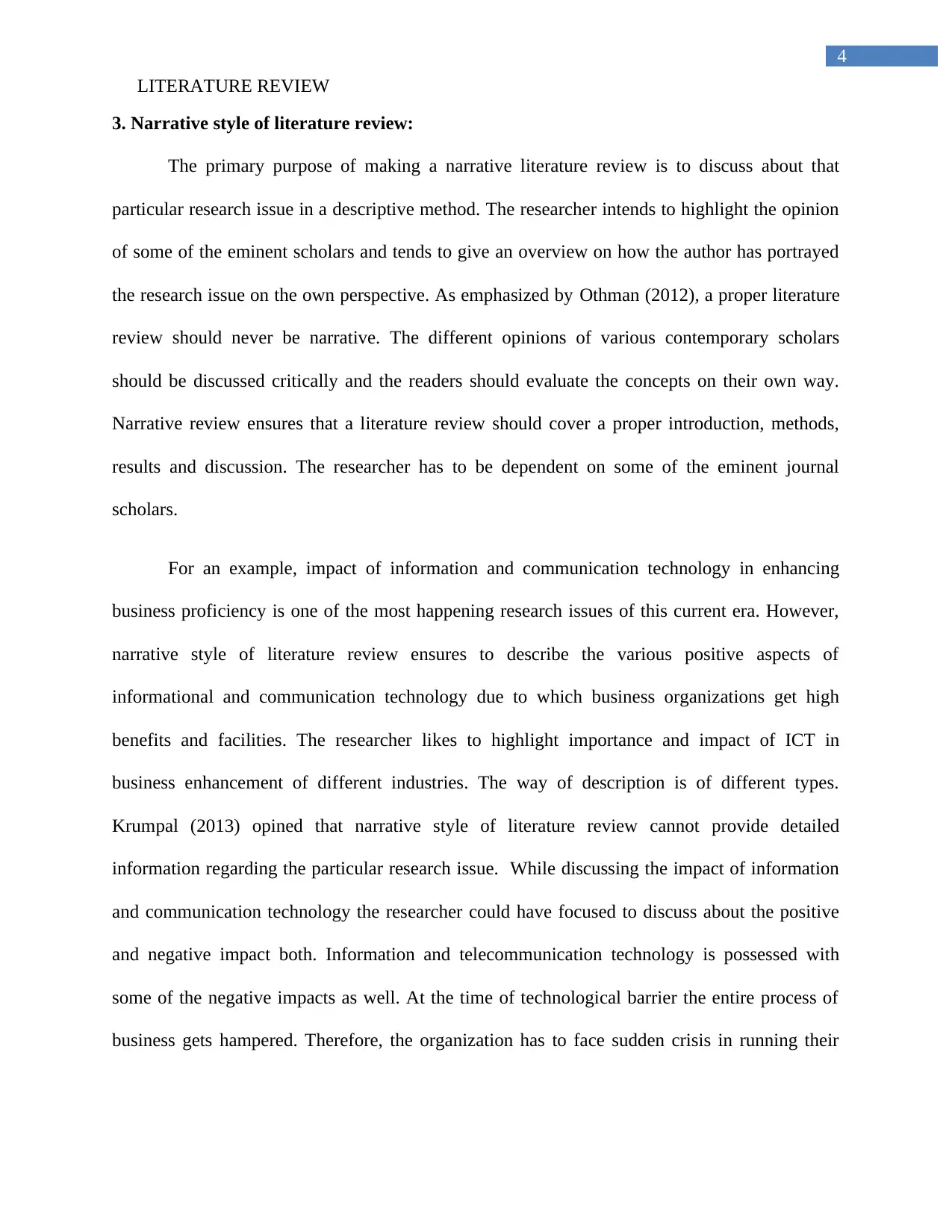
4
LITERATURE REVIEW
3. Narrative style of literature review:
The primary purpose of making a narrative literature review is to discuss about that
particular research issue in a descriptive method. The researcher intends to highlight the opinion
of some of the eminent scholars and tends to give an overview on how the author has portrayed
the research issue on the own perspective. As emphasized by Othman (2012), a proper literature
review should never be narrative. The different opinions of various contemporary scholars
should be discussed critically and the readers should evaluate the concepts on their own way.
Narrative review ensures that a literature review should cover a proper introduction, methods,
results and discussion. The researcher has to be dependent on some of the eminent journal
scholars.
For an example, impact of information and communication technology in enhancing
business proficiency is one of the most happening research issues of this current era. However,
narrative style of literature review ensures to describe the various positive aspects of
informational and communication technology due to which business organizations get high
benefits and facilities. The researcher likes to highlight importance and impact of ICT in
business enhancement of different industries. The way of description is of different types.
Krumpal (2013) opined that narrative style of literature review cannot provide detailed
information regarding the particular research issue. While discussing the impact of information
and communication technology the researcher could have focused to discuss about the positive
and negative impact both. Information and telecommunication technology is possessed with
some of the negative impacts as well. At the time of technological barrier the entire process of
business gets hampered. Therefore, the organization has to face sudden crisis in running their
LITERATURE REVIEW
3. Narrative style of literature review:
The primary purpose of making a narrative literature review is to discuss about that
particular research issue in a descriptive method. The researcher intends to highlight the opinion
of some of the eminent scholars and tends to give an overview on how the author has portrayed
the research issue on the own perspective. As emphasized by Othman (2012), a proper literature
review should never be narrative. The different opinions of various contemporary scholars
should be discussed critically and the readers should evaluate the concepts on their own way.
Narrative review ensures that a literature review should cover a proper introduction, methods,
results and discussion. The researcher has to be dependent on some of the eminent journal
scholars.
For an example, impact of information and communication technology in enhancing
business proficiency is one of the most happening research issues of this current era. However,
narrative style of literature review ensures to describe the various positive aspects of
informational and communication technology due to which business organizations get high
benefits and facilities. The researcher likes to highlight importance and impact of ICT in
business enhancement of different industries. The way of description is of different types.
Krumpal (2013) opined that narrative style of literature review cannot provide detailed
information regarding the particular research issue. While discussing the impact of information
and communication technology the researcher could have focused to discuss about the positive
and negative impact both. Information and telecommunication technology is possessed with
some of the negative impacts as well. At the time of technological barrier the entire process of
business gets hampered. Therefore, the organization has to face sudden crisis in running their

5
LITERATURE REVIEW
business systematically. With the help of numerous contemporary scholars the research issue can
be conducted with the help of critical evaluation.
Critical evaluation ensures that both the positive as well as negative opinions of different
scholars would be depicted in the form of argumentative statement. As per the opinion of a
particular scholar ICT is possessed with numerous positive impacts in influencing the customer
behavior. People do not have to face difficulties in communicating with the service providers
after the emergence of ICT. On the other hand, some of the eminent scholars have opined that
employees should have enough skill and competency in operating the entire process of
technology (Hyde et al. 2012). Otherwise, it can hamper in rendering the business success. This
particular research issue has been set up hypothetically based on which a difference can be
created between narrative review and argumentative review.
4. Style of comparative analysis:
The style of comparative analysis of a literature review has been formed from various
perspectives. As per the point of view of Ramdhani, Ramdhani and Amin (2014), comparative
analysis has been conducted by highlighting the journal articles of some of the recognized
scholars. Their point of views has been presented a different ways. The scholars who have
supported the research issues are highlighted in the first paragraph. In the immediate paragraph
the opinion of other scholars and their different perspectives are highlighted. On the other hand,
Bon and Mustafa (2013) stated that after making an effective thematic analysis with the help of
scholars’ opinion an effective comparison can be prepared. The primary aim of making a
thematic analysis is creating a proper theme based on the research issue. After creating a theme
on research issue the eminent research scholars tend to provide their own opinion. Some of the
LITERATURE REVIEW
business systematically. With the help of numerous contemporary scholars the research issue can
be conducted with the help of critical evaluation.
Critical evaluation ensures that both the positive as well as negative opinions of different
scholars would be depicted in the form of argumentative statement. As per the opinion of a
particular scholar ICT is possessed with numerous positive impacts in influencing the customer
behavior. People do not have to face difficulties in communicating with the service providers
after the emergence of ICT. On the other hand, some of the eminent scholars have opined that
employees should have enough skill and competency in operating the entire process of
technology (Hyde et al. 2012). Otherwise, it can hamper in rendering the business success. This
particular research issue has been set up hypothetically based on which a difference can be
created between narrative review and argumentative review.
4. Style of comparative analysis:
The style of comparative analysis of a literature review has been formed from various
perspectives. As per the point of view of Ramdhani, Ramdhani and Amin (2014), comparative
analysis has been conducted by highlighting the journal articles of some of the recognized
scholars. Their point of views has been presented a different ways. The scholars who have
supported the research issues are highlighted in the first paragraph. In the immediate paragraph
the opinion of other scholars and their different perspectives are highlighted. On the other hand,
Bon and Mustafa (2013) stated that after making an effective thematic analysis with the help of
scholars’ opinion an effective comparison can be prepared. The primary aim of making a
thematic analysis is creating a proper theme based on the research issue. After creating a theme
on research issue the eminent research scholars tend to provide their own opinion. Some of the
⊘ This is a preview!⊘
Do you want full access?
Subscribe today to unlock all pages.

Trusted by 1+ million students worldwide
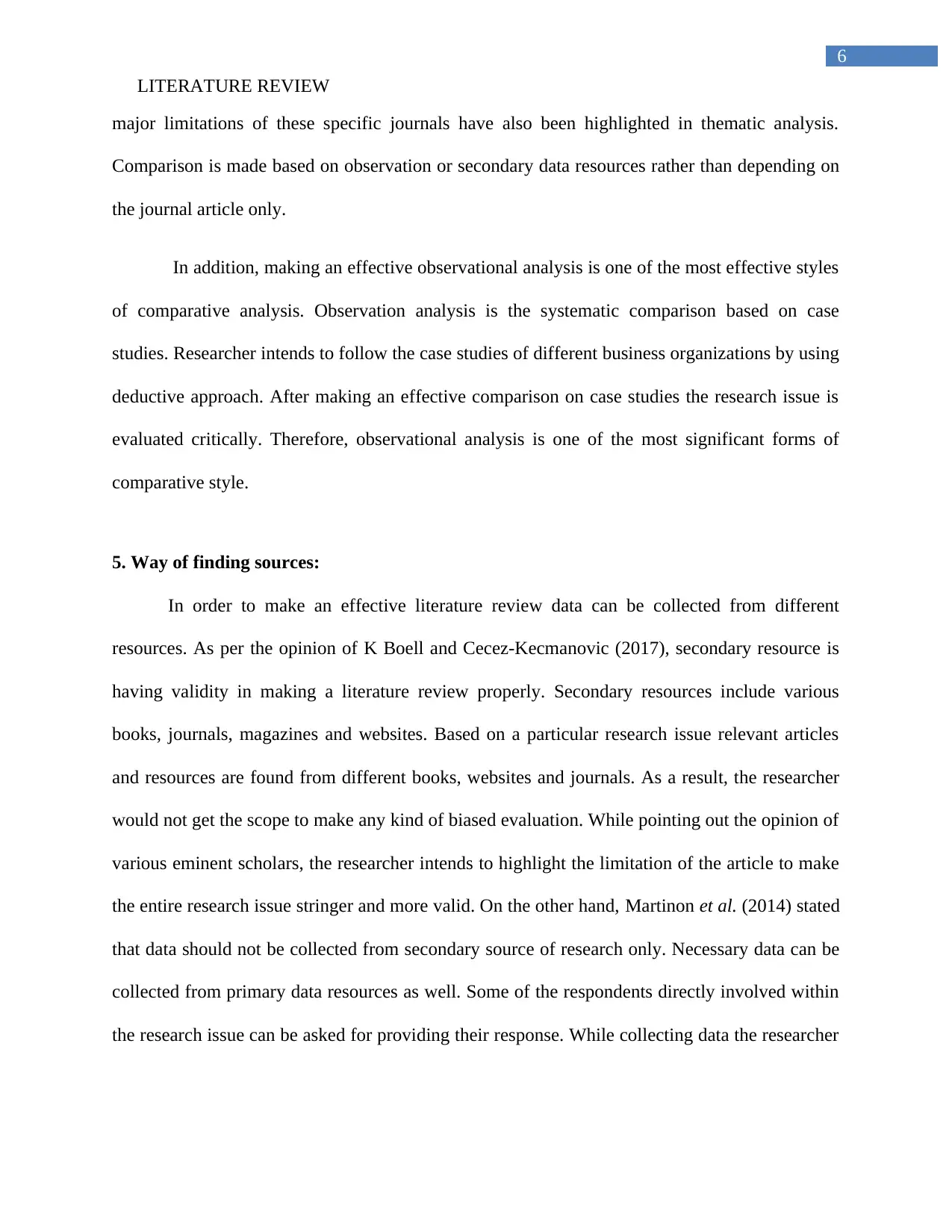
6
LITERATURE REVIEW
major limitations of these specific journals have also been highlighted in thematic analysis.
Comparison is made based on observation or secondary data resources rather than depending on
the journal article only.
In addition, making an effective observational analysis is one of the most effective styles
of comparative analysis. Observation analysis is the systematic comparison based on case
studies. Researcher intends to follow the case studies of different business organizations by using
deductive approach. After making an effective comparison on case studies the research issue is
evaluated critically. Therefore, observational analysis is one of the most significant forms of
comparative style.
5. Way of finding sources:
In order to make an effective literature review data can be collected from different
resources. As per the opinion of K Boell and Cecez-Kecmanovic (2017), secondary resource is
having validity in making a literature review properly. Secondary resources include various
books, journals, magazines and websites. Based on a particular research issue relevant articles
and resources are found from different books, websites and journals. As a result, the researcher
would not get the scope to make any kind of biased evaluation. While pointing out the opinion of
various eminent scholars, the researcher intends to highlight the limitation of the article to make
the entire research issue stringer and more valid. On the other hand, Martinon et al. (2014) stated
that data should not be collected from secondary source of research only. Necessary data can be
collected from primary data resources as well. Some of the respondents directly involved within
the research issue can be asked for providing their response. While collecting data the researcher
LITERATURE REVIEW
major limitations of these specific journals have also been highlighted in thematic analysis.
Comparison is made based on observation or secondary data resources rather than depending on
the journal article only.
In addition, making an effective observational analysis is one of the most effective styles
of comparative analysis. Observation analysis is the systematic comparison based on case
studies. Researcher intends to follow the case studies of different business organizations by using
deductive approach. After making an effective comparison on case studies the research issue is
evaluated critically. Therefore, observational analysis is one of the most significant forms of
comparative style.
5. Way of finding sources:
In order to make an effective literature review data can be collected from different
resources. As per the opinion of K Boell and Cecez-Kecmanovic (2017), secondary resource is
having validity in making a literature review properly. Secondary resources include various
books, journals, magazines and websites. Based on a particular research issue relevant articles
and resources are found from different books, websites and journals. As a result, the researcher
would not get the scope to make any kind of biased evaluation. While pointing out the opinion of
various eminent scholars, the researcher intends to highlight the limitation of the article to make
the entire research issue stringer and more valid. On the other hand, Martinon et al. (2014) stated
that data should not be collected from secondary source of research only. Necessary data can be
collected from primary data resources as well. Some of the respondents directly involved within
the research issue can be asked for providing their response. While collecting data the researcher
Paraphrase This Document
Need a fresh take? Get an instant paraphrase of this document with our AI Paraphraser
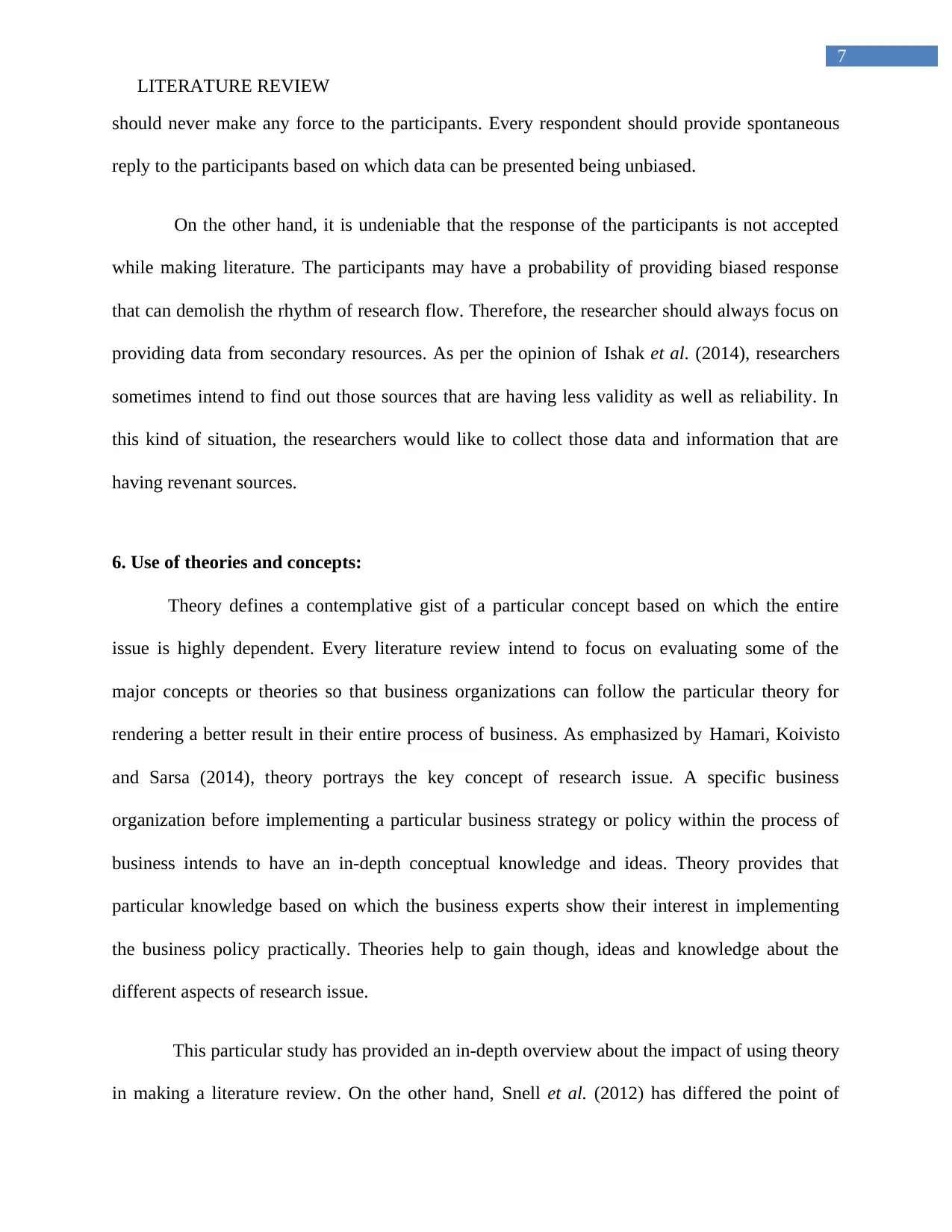
7
LITERATURE REVIEW
should never make any force to the participants. Every respondent should provide spontaneous
reply to the participants based on which data can be presented being unbiased.
On the other hand, it is undeniable that the response of the participants is not accepted
while making literature. The participants may have a probability of providing biased response
that can demolish the rhythm of research flow. Therefore, the researcher should always focus on
providing data from secondary resources. As per the opinion of Ishak et al. (2014), researchers
sometimes intend to find out those sources that are having less validity as well as reliability. In
this kind of situation, the researchers would like to collect those data and information that are
having revenant sources.
6. Use of theories and concepts:
Theory defines a contemplative gist of a particular concept based on which the entire
issue is highly dependent. Every literature review intend to focus on evaluating some of the
major concepts or theories so that business organizations can follow the particular theory for
rendering a better result in their entire process of business. As emphasized by Hamari, Koivisto
and Sarsa (2014), theory portrays the key concept of research issue. A specific business
organization before implementing a particular business strategy or policy within the process of
business intends to have an in-depth conceptual knowledge and ideas. Theory provides that
particular knowledge based on which the business experts show their interest in implementing
the business policy practically. Theories help to gain though, ideas and knowledge about the
different aspects of research issue.
This particular study has provided an in-depth overview about the impact of using theory
in making a literature review. On the other hand, Snell et al. (2012) has differed the point of
LITERATURE REVIEW
should never make any force to the participants. Every respondent should provide spontaneous
reply to the participants based on which data can be presented being unbiased.
On the other hand, it is undeniable that the response of the participants is not accepted
while making literature. The participants may have a probability of providing biased response
that can demolish the rhythm of research flow. Therefore, the researcher should always focus on
providing data from secondary resources. As per the opinion of Ishak et al. (2014), researchers
sometimes intend to find out those sources that are having less validity as well as reliability. In
this kind of situation, the researchers would like to collect those data and information that are
having revenant sources.
6. Use of theories and concepts:
Theory defines a contemplative gist of a particular concept based on which the entire
issue is highly dependent. Every literature review intend to focus on evaluating some of the
major concepts or theories so that business organizations can follow the particular theory for
rendering a better result in their entire process of business. As emphasized by Hamari, Koivisto
and Sarsa (2014), theory portrays the key concept of research issue. A specific business
organization before implementing a particular business strategy or policy within the process of
business intends to have an in-depth conceptual knowledge and ideas. Theory provides that
particular knowledge based on which the business experts show their interest in implementing
the business policy practically. Theories help to gain though, ideas and knowledge about the
different aspects of research issue.
This particular study has provided an in-depth overview about the impact of using theory
in making a literature review. On the other hand, Snell et al. (2012) has differed the point of
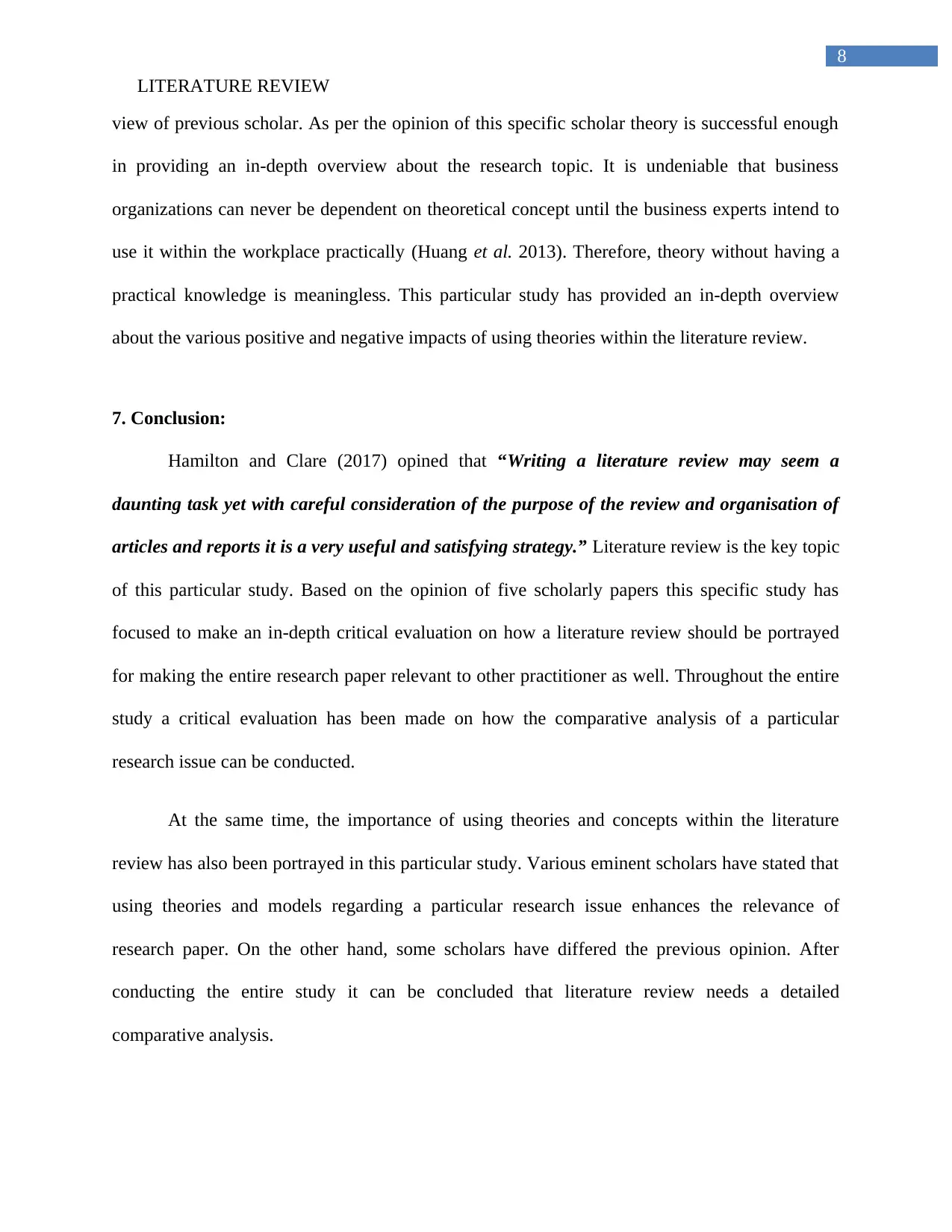
8
LITERATURE REVIEW
view of previous scholar. As per the opinion of this specific scholar theory is successful enough
in providing an in-depth overview about the research topic. It is undeniable that business
organizations can never be dependent on theoretical concept until the business experts intend to
use it within the workplace practically (Huang et al. 2013). Therefore, theory without having a
practical knowledge is meaningless. This particular study has provided an in-depth overview
about the various positive and negative impacts of using theories within the literature review.
7. Conclusion:
Hamilton and Clare (2017) opined that “Writing a literature review may seem a
daunting task yet with careful consideration of the purpose of the review and organisation of
articles and reports it is a very useful and satisfying strategy.” Literature review is the key topic
of this particular study. Based on the opinion of five scholarly papers this specific study has
focused to make an in-depth critical evaluation on how a literature review should be portrayed
for making the entire research paper relevant to other practitioner as well. Throughout the entire
study a critical evaluation has been made on how the comparative analysis of a particular
research issue can be conducted.
At the same time, the importance of using theories and concepts within the literature
review has also been portrayed in this particular study. Various eminent scholars have stated that
using theories and models regarding a particular research issue enhances the relevance of
research paper. On the other hand, some scholars have differed the previous opinion. After
conducting the entire study it can be concluded that literature review needs a detailed
comparative analysis.
LITERATURE REVIEW
view of previous scholar. As per the opinion of this specific scholar theory is successful enough
in providing an in-depth overview about the research topic. It is undeniable that business
organizations can never be dependent on theoretical concept until the business experts intend to
use it within the workplace practically (Huang et al. 2013). Therefore, theory without having a
practical knowledge is meaningless. This particular study has provided an in-depth overview
about the various positive and negative impacts of using theories within the literature review.
7. Conclusion:
Hamilton and Clare (2017) opined that “Writing a literature review may seem a
daunting task yet with careful consideration of the purpose of the review and organisation of
articles and reports it is a very useful and satisfying strategy.” Literature review is the key topic
of this particular study. Based on the opinion of five scholarly papers this specific study has
focused to make an in-depth critical evaluation on how a literature review should be portrayed
for making the entire research paper relevant to other practitioner as well. Throughout the entire
study a critical evaluation has been made on how the comparative analysis of a particular
research issue can be conducted.
At the same time, the importance of using theories and concepts within the literature
review has also been portrayed in this particular study. Various eminent scholars have stated that
using theories and models regarding a particular research issue enhances the relevance of
research paper. On the other hand, some scholars have differed the previous opinion. After
conducting the entire study it can be concluded that literature review needs a detailed
comparative analysis.
⊘ This is a preview!⊘
Do you want full access?
Subscribe today to unlock all pages.

Trusted by 1+ million students worldwide
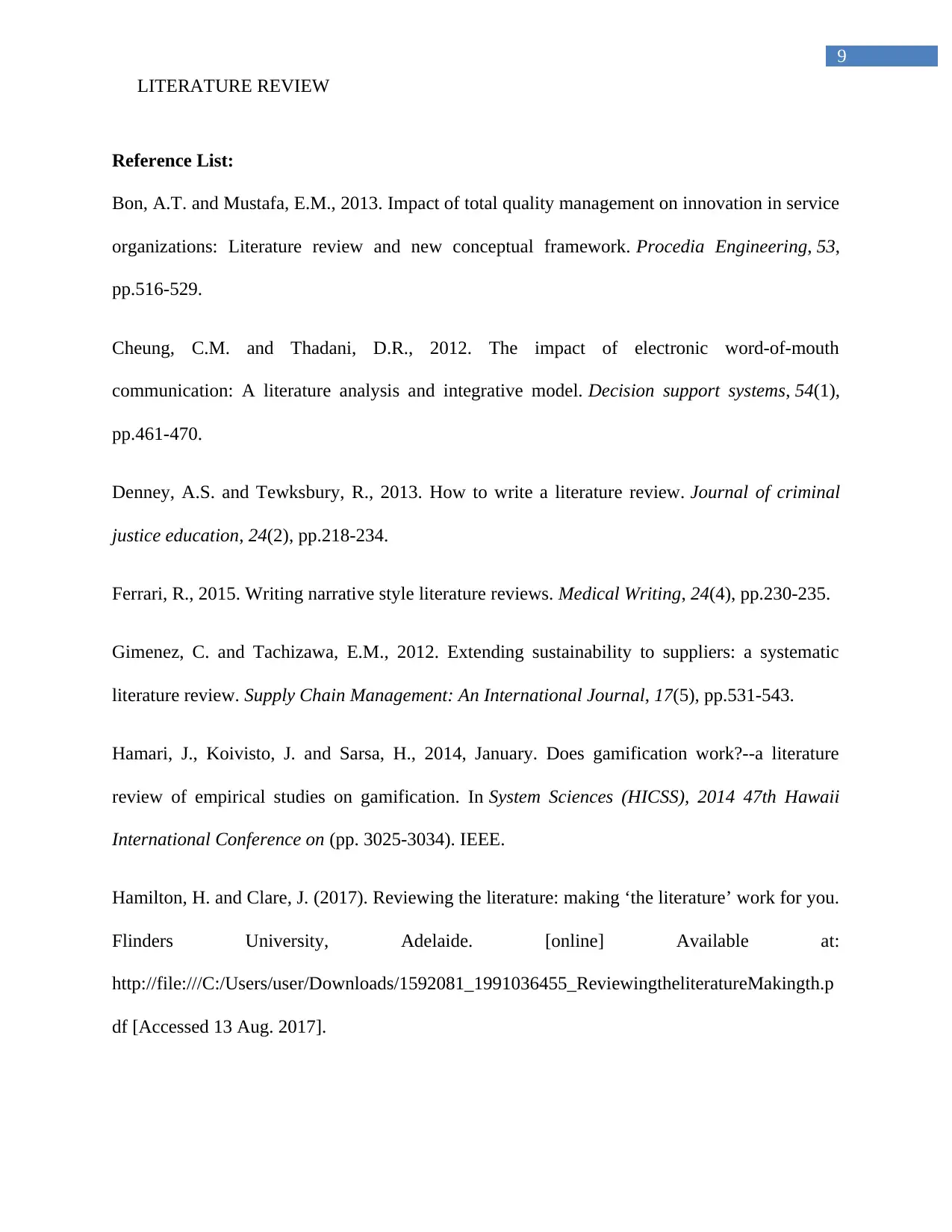
9
LITERATURE REVIEW
Reference List:
Bon, A.T. and Mustafa, E.M., 2013. Impact of total quality management on innovation in service
organizations: Literature review and new conceptual framework. Procedia Engineering, 53,
pp.516-529.
Cheung, C.M. and Thadani, D.R., 2012. The impact of electronic word-of-mouth
communication: A literature analysis and integrative model. Decision support systems, 54(1),
pp.461-470.
Denney, A.S. and Tewksbury, R., 2013. How to write a literature review. Journal of criminal
justice education, 24(2), pp.218-234.
Ferrari, R., 2015. Writing narrative style literature reviews. Medical Writing, 24(4), pp.230-235.
Gimenez, C. and Tachizawa, E.M., 2012. Extending sustainability to suppliers: a systematic
literature review. Supply Chain Management: An International Journal, 17(5), pp.531-543.
Hamari, J., Koivisto, J. and Sarsa, H., 2014, January. Does gamification work?--a literature
review of empirical studies on gamification. In System Sciences (HICSS), 2014 47th Hawaii
International Conference on (pp. 3025-3034). IEEE.
Hamilton, H. and Clare, J. (2017). Reviewing the literature: making ‘the literature’ work for you.
Flinders University, Adelaide. [online] Available at:
http://file:///C:/Users/user/Downloads/1592081_1991036455_ReviewingtheliteratureMakingth.p
df [Accessed 13 Aug. 2017].
LITERATURE REVIEW
Reference List:
Bon, A.T. and Mustafa, E.M., 2013. Impact of total quality management on innovation in service
organizations: Literature review and new conceptual framework. Procedia Engineering, 53,
pp.516-529.
Cheung, C.M. and Thadani, D.R., 2012. The impact of electronic word-of-mouth
communication: A literature analysis and integrative model. Decision support systems, 54(1),
pp.461-470.
Denney, A.S. and Tewksbury, R., 2013. How to write a literature review. Journal of criminal
justice education, 24(2), pp.218-234.
Ferrari, R., 2015. Writing narrative style literature reviews. Medical Writing, 24(4), pp.230-235.
Gimenez, C. and Tachizawa, E.M., 2012. Extending sustainability to suppliers: a systematic
literature review. Supply Chain Management: An International Journal, 17(5), pp.531-543.
Hamari, J., Koivisto, J. and Sarsa, H., 2014, January. Does gamification work?--a literature
review of empirical studies on gamification. In System Sciences (HICSS), 2014 47th Hawaii
International Conference on (pp. 3025-3034). IEEE.
Hamilton, H. and Clare, J. (2017). Reviewing the literature: making ‘the literature’ work for you.
Flinders University, Adelaide. [online] Available at:
http://file:///C:/Users/user/Downloads/1592081_1991036455_ReviewingtheliteratureMakingth.p
df [Accessed 13 Aug. 2017].
Paraphrase This Document
Need a fresh take? Get an instant paraphrase of this document with our AI Paraphraser
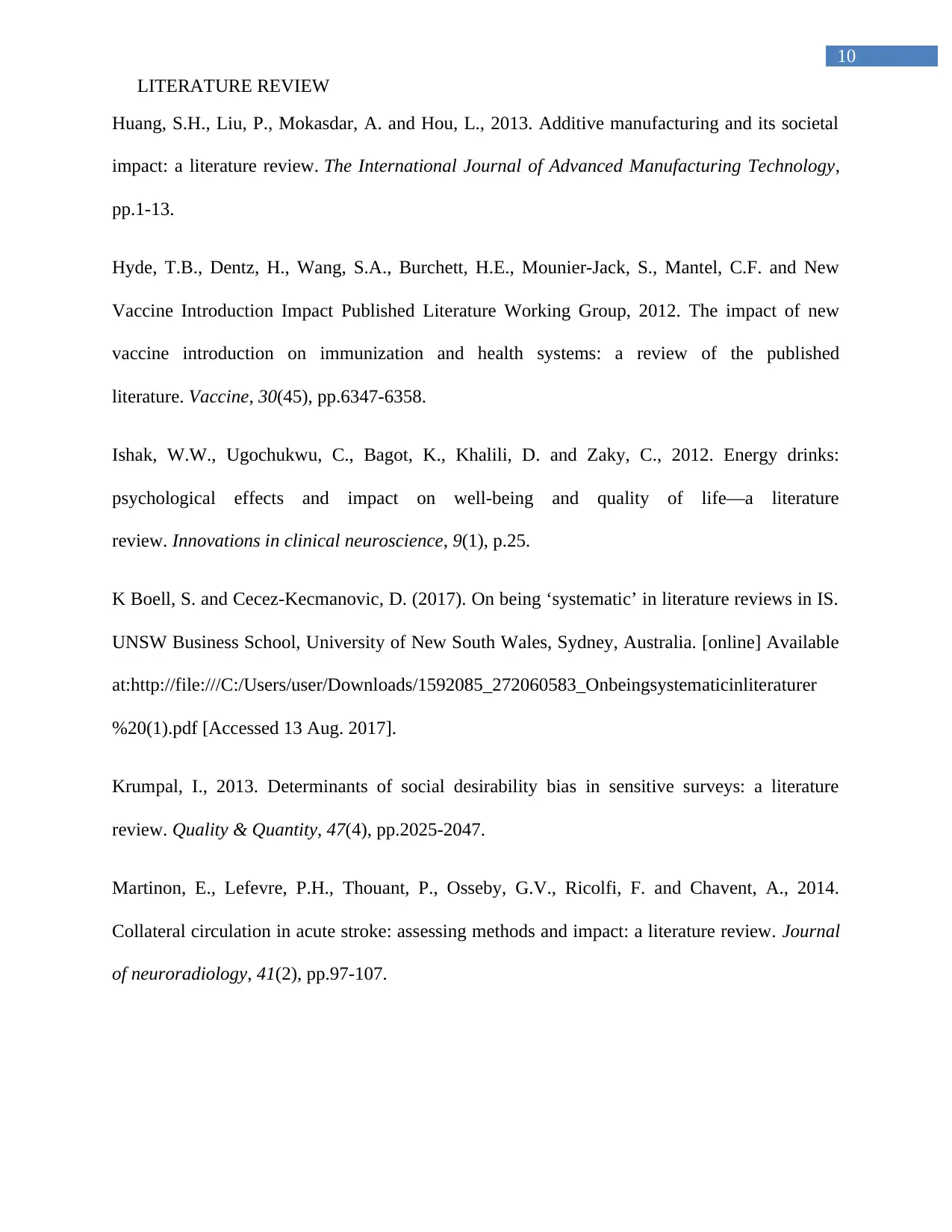
10
LITERATURE REVIEW
Huang, S.H., Liu, P., Mokasdar, A. and Hou, L., 2013. Additive manufacturing and its societal
impact: a literature review. The International Journal of Advanced Manufacturing Technology,
pp.1-13.
Hyde, T.B., Dentz, H., Wang, S.A., Burchett, H.E., Mounier-Jack, S., Mantel, C.F. and New
Vaccine Introduction Impact Published Literature Working Group, 2012. The impact of new
vaccine introduction on immunization and health systems: a review of the published
literature. Vaccine, 30(45), pp.6347-6358.
Ishak, W.W., Ugochukwu, C., Bagot, K., Khalili, D. and Zaky, C., 2012. Energy drinks:
psychological effects and impact on well-being and quality of life—a literature
review. Innovations in clinical neuroscience, 9(1), p.25.
K Boell, S. and Cecez-Kecmanovic, D. (2017). On being ‘systematic’ in literature reviews in IS.
UNSW Business School, University of New South Wales, Sydney, Australia. [online] Available
at:http://file:///C:/Users/user/Downloads/1592085_272060583_Onbeingsystematicinliteraturer
%20(1).pdf [Accessed 13 Aug. 2017].
Krumpal, I., 2013. Determinants of social desirability bias in sensitive surveys: a literature
review. Quality & Quantity, 47(4), pp.2025-2047.
Martinon, E., Lefevre, P.H., Thouant, P., Osseby, G.V., Ricolfi, F. and Chavent, A., 2014.
Collateral circulation in acute stroke: assessing methods and impact: a literature review. Journal
of neuroradiology, 41(2), pp.97-107.
LITERATURE REVIEW
Huang, S.H., Liu, P., Mokasdar, A. and Hou, L., 2013. Additive manufacturing and its societal
impact: a literature review. The International Journal of Advanced Manufacturing Technology,
pp.1-13.
Hyde, T.B., Dentz, H., Wang, S.A., Burchett, H.E., Mounier-Jack, S., Mantel, C.F. and New
Vaccine Introduction Impact Published Literature Working Group, 2012. The impact of new
vaccine introduction on immunization and health systems: a review of the published
literature. Vaccine, 30(45), pp.6347-6358.
Ishak, W.W., Ugochukwu, C., Bagot, K., Khalili, D. and Zaky, C., 2012. Energy drinks:
psychological effects and impact on well-being and quality of life—a literature
review. Innovations in clinical neuroscience, 9(1), p.25.
K Boell, S. and Cecez-Kecmanovic, D. (2017). On being ‘systematic’ in literature reviews in IS.
UNSW Business School, University of New South Wales, Sydney, Australia. [online] Available
at:http://file:///C:/Users/user/Downloads/1592085_272060583_Onbeingsystematicinliteraturer
%20(1).pdf [Accessed 13 Aug. 2017].
Krumpal, I., 2013. Determinants of social desirability bias in sensitive surveys: a literature
review. Quality & Quantity, 47(4), pp.2025-2047.
Martinon, E., Lefevre, P.H., Thouant, P., Osseby, G.V., Ricolfi, F. and Chavent, A., 2014.
Collateral circulation in acute stroke: assessing methods and impact: a literature review. Journal
of neuroradiology, 41(2), pp.97-107.
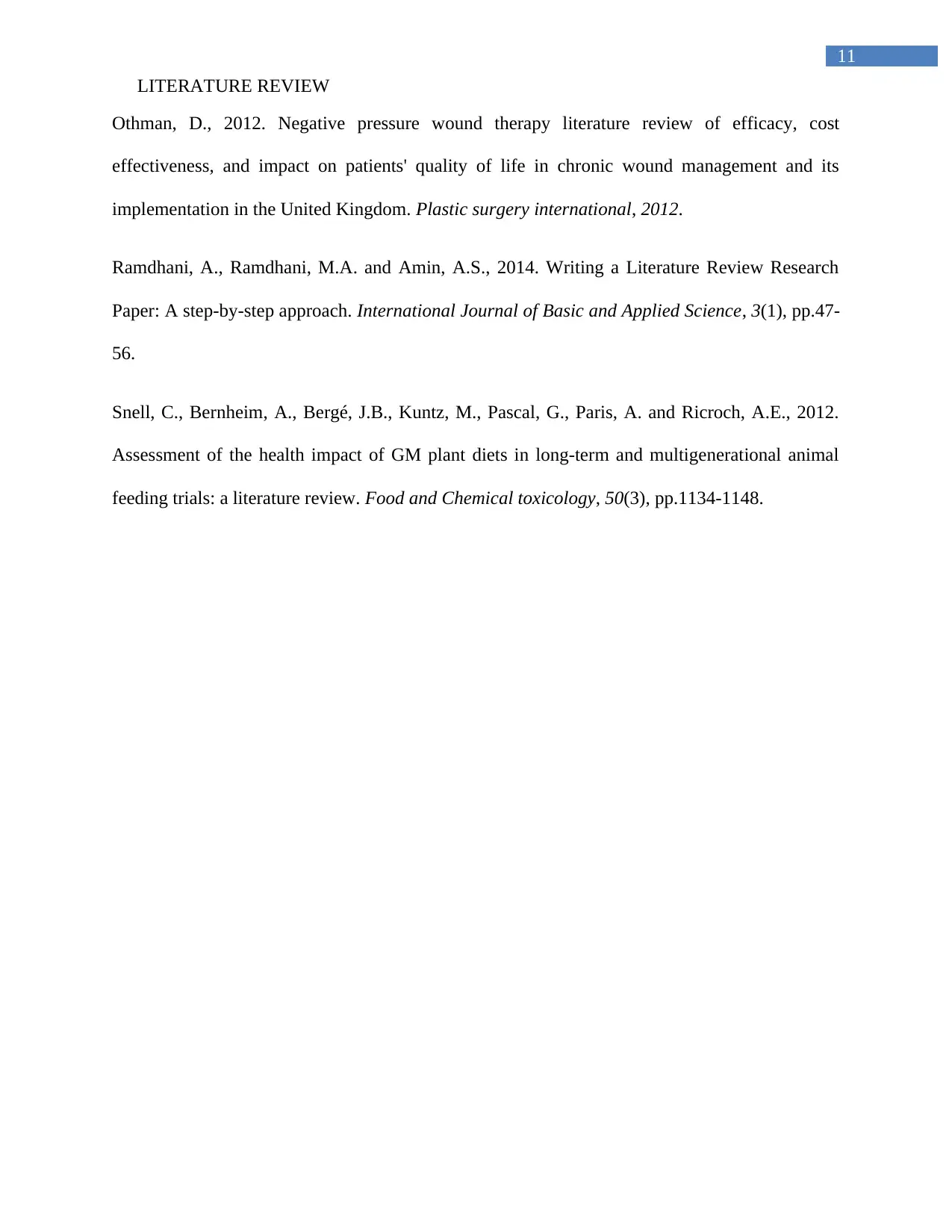
11
LITERATURE REVIEW
Othman, D., 2012. Negative pressure wound therapy literature review of efficacy, cost
effectiveness, and impact on patients' quality of life in chronic wound management and its
implementation in the United Kingdom. Plastic surgery international, 2012.
Ramdhani, A., Ramdhani, M.A. and Amin, A.S., 2014. Writing a Literature Review Research
Paper: A step-by-step approach. International Journal of Basic and Applied Science, 3(1), pp.47-
56.
Snell, C., Bernheim, A., Bergé, J.B., Kuntz, M., Pascal, G., Paris, A. and Ricroch, A.E., 2012.
Assessment of the health impact of GM plant diets in long-term and multigenerational animal
feeding trials: a literature review. Food and Chemical toxicology, 50(3), pp.1134-1148.
LITERATURE REVIEW
Othman, D., 2012. Negative pressure wound therapy literature review of efficacy, cost
effectiveness, and impact on patients' quality of life in chronic wound management and its
implementation in the United Kingdom. Plastic surgery international, 2012.
Ramdhani, A., Ramdhani, M.A. and Amin, A.S., 2014. Writing a Literature Review Research
Paper: A step-by-step approach. International Journal of Basic and Applied Science, 3(1), pp.47-
56.
Snell, C., Bernheim, A., Bergé, J.B., Kuntz, M., Pascal, G., Paris, A. and Ricroch, A.E., 2012.
Assessment of the health impact of GM plant diets in long-term and multigenerational animal
feeding trials: a literature review. Food and Chemical toxicology, 50(3), pp.1134-1148.
⊘ This is a preview!⊘
Do you want full access?
Subscribe today to unlock all pages.

Trusted by 1+ million students worldwide
1 out of 12
Related Documents
Your All-in-One AI-Powered Toolkit for Academic Success.
+13062052269
info@desklib.com
Available 24*7 on WhatsApp / Email
![[object Object]](/_next/static/media/star-bottom.7253800d.svg)
Unlock your academic potential
Copyright © 2020–2025 A2Z Services. All Rights Reserved. Developed and managed by ZUCOL.





